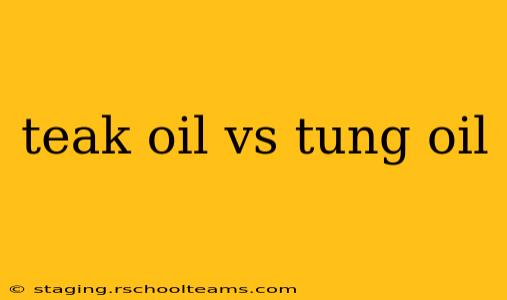Choosing the right oil for finishing your prized wooden furniture or outdoor project can feel overwhelming. Two popular choices often top the list: teak oil and tung oil. While both offer protection and enhance the beauty of wood, they have distinct properties and applications. This comprehensive guide will delve into the key differences between teak oil and tung oil, helping you make an informed decision for your specific needs.
What is Teak Oil?
Teak oil isn't actually derived from teak trees. Instead, it's typically a blend of mineral oil, linseed oil, and sometimes other drying oils, often with added solvents and UV inhibitors. It's marketed as "teak oil" because it's commonly used on teak furniture, prized for its weather resistance. The blend provides a protective layer that repels water and protects against the elements. However, it's important to note that the "teak oil" you buy at the hardware store isn't a pure oil extracted from teak trees.
What is Tung Oil?
Tung oil, on the other hand, is a true natural oil pressed from the nuts of the tung tree. It's a highly durable, penetrating oil that polymerizes (hardens) upon exposure to air, creating a hard, protective finish. This process, known as oxidation, is what gives tung oil its long-lasting durability. Unlike teak oil, pure tung oil requires multiple coats to achieve a satisfactory level of protection.
Teak Oil vs. Tung Oil: Key Differences
Here's a head-to-head comparison highlighting the key distinctions:
| Feature | Teak Oil | Tung Oil |
|---|---|---|
| Composition | Blend of oils (mineral, linseed, etc.) | Pure oil from tung nuts |
| Drying Time | Relatively fast | Relatively slow (multiple thin coats needed) |
| Durability | Moderate; requires more frequent reapplication | High; long-lasting protective layer |
| Penetration | Moderate | Deep penetration into wood fibers |
| Water Resistance | Moderate | Good |
| UV Resistance | Often contains UV inhibitors | Requires additional UV protection (e.g., varnish) |
| Cost | Generally less expensive | Generally more expensive |
| Application | Easier application | Requires more patience and thinner coats |
Which Oil is Right for My Project?
The best choice depends on your project's specific needs and your desired level of effort:
-
Outdoor Furniture: For outdoor furniture exposed to harsh weather, tung oil offers superior long-term protection, though it requires more coats and patience. Teak oil might be suitable for less demanding conditions, but it will require more frequent reapplication.
-
Indoor Furniture: Both oils can be used indoors. However, tung oil's durability makes it a better choice for high-traffic areas or valuable pieces.
-
DIY Enthusiasts: Teak oil is generally easier to apply for beginners due to its faster drying time.
-
Experienced Woodworkers: Tung oil, while more time-consuming, provides a superior and long-lasting finish.
How to Apply Teak Oil and Tung Oil
Both oils require proper preparation of the wood surface, including cleaning and sanding. Application techniques vary slightly; always follow the manufacturer's instructions for the specific oil you choose. Thin coats are essential for both oils to allow for proper penetration.
What are the Benefits of Using Teak Oil?
- Easy Application: Its faster drying time and simpler application make it a convenient option.
- Cost-Effective: Generally less expensive than pure tung oil.
- Good for Quick Protection: Provides adequate protection for furniture not exposed to extreme conditions.
What are the Benefits of Using Tung Oil?
- Superior Durability: Offers long-lasting protection against water, UV damage, and wear.
- Deep Penetration: Penetrates deeply into the wood, enhancing its natural beauty and protection.
- Water Resistance: More water-resistant than teak oil.
Is teak oil food safe? Is tung oil food safe?
Neither teak oil nor typical tung oil formulations are generally considered food safe without specific food-grade certifications. Always use food-safe oils or finishes specifically designed for surfaces that will come into contact with food.
Can I mix teak oil and tung oil?
Mixing teak oil and tung oil is generally not recommended. The differing compositions may lead to unpredictable results, potentially compromising the final finish's durability and appearance.
By understanding the differences between teak oil and tung oil, you can choose the right oil to protect and enhance your wood for years to come. Remember to always read and follow the manufacturer's instructions for best results.
